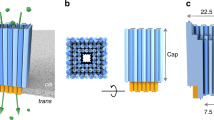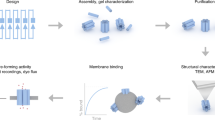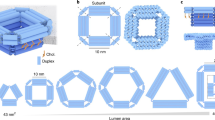Abstract
Synthetic solid-state nanopores are being intensively investigated as single-molecule sensors for detection and characterization of DNA, RNA and proteins. This field has been inspired by the exquisite selectivity and flux demonstrated by natural biological channels and the dream of emulating these behaviours in more robust synthetic materials that are more readily integrated into practical devices. So far, the guided etching of polymer films, focused ion-beam sculpting, and electron-beam lithography and tuning of silicon nitride membranes have emerged as three promising approaches to define synthetic solid-state pores with sub-nanometre resolution. These procedures have in common the formation of nominally cylindrical or conical pores aligned normal to the membrane surface. Here we report the formation of ‘kinked’ silica nanopores, using evaporation-induced self-assembly, and their further tuning and chemical derivatization using atomic-layer deposition. Compared with ‘straight through’ proteinaceous nanopores of comparable dimensions, kinked nanopores exhibit up to fivefold reduction in translocation velocity, which has been identified as one of the critical issues in DNA sequencing. Additionally, we demonstrate an efficient two-step approach to create a nanopore array exhibiting nearly perfect selectivity for ssDNA over dsDNA. We show that a coarse-grained drift–diffusion theory with a sawtooth-like potential can reasonably describe the velocity and translocation time of DNA through the pore. By control of pore size, length and shape, we capture the main functional behaviours of protein pores in our solid-state nanopore system.
This is a preview of subscription content, access via your institution
Access options
Subscribe to this journal
Receive 12 print issues and online access
$259.00 per year
only $21.58 per issue
Buy this article
- Purchase on Springer Link
- Instant access to full article PDF
Prices may be subject to local taxes which are calculated during checkout






Similar content being viewed by others
References
Coulter, W. H. Means for counting particles suspended in a fluid. US Patent 2,656,508 (1953).
Siwy, Z. & Fulinski, A. Fabrication of a synthetic nanopore ion pump. Phys. Rev. Lett. 89, 198103 (2002).
Li, J. et al. Ion-beam sculpting at nanometre length scales. Nature 412, 166–169 (2001).
Storm, A. J., Chen, J. H., Ling, X. S., Zandbergen, H. W. & Dekker, C. Fabrication of solid-state nanopores with single-nanometre precision. Nature Mater. 2, 537–540 (2003).
Ho, C. et al. Electrolytic transport through a synthetic nanometer-diameter pore. Proc. Natl Acad. Sci. USA 102, 10445–10450 (2005).
Branton, D. et al. The potential and challenges of nanopore sequencing. Nature Biotechnol. 26, 1146–1153 (2008).
Dekker, C. Solid-state nanopores. Nature Nanotech. 2, 209–215 (2007).
Nakane, J. J., Akeson, M. & Marziali, A. Nanopore sensors for nucleic acid analysis. J. Phys. Condens. Matter 15, R1365–R1393 (2003).
Fologea, D., Uplinger, J., Thomas, B., McNabb, D. S. & Li, J. L. Slowing DNA translocation in a solid-state nanopore. Nano Lett. 5, 1734–1737 (2005).
de Zoysa, R. S. S. et al. Slowing DNA translocation through nanopores using a solution containing organic salts. J. Phys. Chem. B 113, 13332–13336 (2009).
Keyser, U. F. et al. Direct force measurements on DNA in a solid-state nanopore. Nature Phys. 2, 473–477 (2006).
Lu, Y. F. et al. Continuous formation of supported cubic and hexagonal mesoporous films by sol gel dip-coating. Nature 389, 364–368 (1997).
Brinker, C. J., Lu, Y. F., Sellinger, A. & Fan, H. Y. Evaporation-induced self-assembly: Nanostructures made easy. Adv. Mater. 11, 579–585 (1999).
Grosso, D. et al. Fundamentals of mesostructuring through evaporation-induced self-assembly. Adv. Funct. Mater. 14, 309–322 (2004).
Xomeritakis, G. et al. Aerosol-assisted deposition of surfactant-templated mesoporous silica membranes on porous ceramic supports. Microporous Mesoporous Mater. 66, 91–101 (2003).
Besson, S., Ricolleau, C., Gacoin, T., Jacquiod, C. & Boilot, J. P. A new 3D organization of mesopores in oriented CTAB silica films. J. Phys. Chem. B 104, 12095–12097 (2000).
Liu, N. G., Assink, R. A., Smarsly, B. & Brinker, C. J. Synthesis and characterization of highly ordered functional mesoporous silica thin films with positively chargeable –NH2 groups. Chem. Commun. 1146–1147 (2003).
Liu, N. G., Assink, R. A. & Brinker, C. J. Synthesis and characterization of highly ordered mesoporous thin films with–COOH terminated pore surfaces. Chem. Commun. 370–371 (2003).
Urade, V. N., Wei, T. C., Tate, M. P., Kowalski, J. D. & Hillhouse, H. W. Nanofabrication of double-gyroid thin films. Chem. Mater. 19, 768–777 (2007).
Tate, M. P. et al. Simulation and interpretation of 2D diffraction patterns from self-assembled nanostructured films at arbitrary angles of incidence: From grazing incidence (above the critical angle) to transmission perpendicular to the substrate. J. Phys. Chem. B 110, 9882–9892 (2006).
Falcaro, P., Grosso, D., Amenitsch, H. & Innocenzi, P. Silica orthorhombic mesostructured films with low refractive index and high thermal stability. J. Phys. Chem. B 108, 10942–10948 (2004).
Besson, S., Ricolleau, C., Gacoin, T., Jacquiod, C. & Boilot, J. P. Highly ordered orthorhombic mesoporous silica films. Microporous Mesoporous Mater. 60, 43–49 (2003).
Ricco, A. J., Frye, G. C. & Martin, S. J. Determination of BET surface-areas of porous thin-films using surface acoustic-wave devices. Langmuir 5, 273–276 (1989).
Patterson, N. et al. Controlled fabrication of nanopores using a direct focused ion beam approach with back face particle detection. Nanotechnology 19, 235304 (2008).
Jiang, Y. B., Liu, N. G., Gerung, H., Cecchi, J. L. & Brinker, C. J. Nanometer-thick conformal pore sealing of self-assembled mesoporous silica by plasma-assisted atomic layer deposition. J. Am. Chem. Soc. 128, 11018 (2006).
Khardani, M., Bouaicha, M. & Bessais, B. Bruggeman effective medium approach for modeling optical properties of porous silicon: Comparison with experiment. Phys. Status Solidi 4, 1986–1990 (2007).
Cameron, M. A., Gartland, I. P., Smith, J. A., Diaz, S. F. & George, S. M. Atomic layer deposition of SiO2 and TiO2 in alumina tubular membranes: Pore reduction and effect of surface species on gas transport. Langmuir 16, 7435–7444 (2000).
Ek, S. et al. Atomic layer deposition of a high-density aminopropylsiloxane network on silica through sequential reactions of gamma-aminopropyltrialkoxysilanes and water. Langmuir 19, 10601–10609 (2003).
Heng, J. B. et al. The electromechanics of DNA in a synthetic nanopore. Biophys. J. 90, 1098–1106 (2006).
Li, J. L., Gershow, M., Stein, D., Brandin, E. & Golovchenko, J. A. DNA molecules and configurations in a solid-state nanopore microscope. Nature Mater. 2, 611–615 (2003).
Smeets, R. M. M. et al. Salt dependence of ion transport and DNA translocation through solid-state nanopores. Nano Lett. 6, 89–95 (2006).
Chen, P. et al. Probing single DNA molecule transport using fabricated nanopores. Nano Lett. 4, 2293–2298 (2004).
Storm, A. J., Chen, J. H., Zandbergen, H. W. & Dekker, C. Translocation of double-strand DNA through a silicon oxide nanopore. Phys. Rev. E 71, 051903 (2005).
Meller, A., Nivon, L. & Branton, D. Voltage-driven DNA translocations through a nanopore. Phys. Rev. Lett. 86, 3435–3438 (2001).
Lubensky, D. K. & Nelson, D. R. Driven polymer translocation through a narrow pore. Biophys. J. 77, 1824–1838 (1999).
Wanunu, M., Sutin, J., McNally, B., Chow, A. & Meller, A. DNA translocation governed by interactions with solid-state nanopores. Biophys. J. 95, 4716–4725 (2008).
Storm, A. J. et al. Fast DNA translocation through a solid-state nanopore. Nano Lett. 5, 1193–1197 (2005).
Deamer, D. W. & Branton, D. Characterization of nucleic acids by nanopore analysis. Acc. Chem. Res. 35, 817–825 (2002).
Kasianowicz, J. J., Brandin, E., Branton, D. & Deamer, D. W. Characterization of individual polynucleotide molecules using a membrane channel. Proc. Natl Acad. Sci. USA 93, 13770–13773 (1996).
Maglia, G., Restrepo, M. R., Mikhailova, E. & Bayley, H. Enhanced translocation of single DNA molecules through alpha-hemolysin nanopores by manipulation of internal charge. Proc. Natl Acad. Sci. USA 105, 19720–19725 (2008).
McNally, B., Wanunu, M. & Meller, A. Electromechanical unzipping of individual DNA molecules using synthetic sub-2 nm pores. Nano Lett. 8, 3418–3422 (2008).
Skinner, G. M., van den Hout, M., Broekmans, O., Dekker, C. & Dekker, N. H. Distinguishing single- and double-stranded nucleic acid molecules using solid-state nanopores. Nano Lett. 9, 2953–2960 (2009).
Meller, A. Dynamics of polynucleotide transport through nanometre-scale pores. J. Phys. Condens. Matter 15, R581–R607 (2003).
Meller, A., Nivon, L., Brandin, E., Golovchenko, J. & Branton, D. Rapid nanopore discrimination between single polynucleotide molecules. Proc. Natl Acad. Sci. USA 97, 1079–1084 (2000).
Smith, D. E., Perkins, T. T. & Chu, S. Dynamical scaling of DNA diffusion coefficients. Macromolecules 29, 1372–1373 (1996).
Lam, P. M., Liu, F. & Ou-Yang, Z. C. Driven translocation of a polynucleotide chain through a nanopore: A continuous time Monte Carlo study. Phys. Rev. E 74, 011911 (2006).
Lua, R. C. & Grosberg, A. Y. First passage times and asymmetry of DNA translocation. Phys. Rev. E 72, 061918 (2005).
Mathe, J., Aksimentiev, A., Nelson, D. R., Schulten, K. & Meller, A. Orientation discrimination of single-stranded DNA inside the alpha-hemolysin membrane channel. Proc. Natl Acad. Sci. USA 102, 12377–12382 (2005).
Peng, H. B. & Ling, X. S. S. Reverse DNA translocation through a solid-state nanopore by magnetic tweezers. Nanotechnology 20, 185101 (2009).
Acknowledgements
This work is supported by the Air Force Office of Scientific Research grant FA 9550-10-1-0054, DOE Basic Energy Sciences grant DE-FG02-02-ER15368, US Department of Energy, Office of Basic Energy Sciences, Division of Materials Sciences and Engineering, and Sandia National Laboratories’ LDRD program. Z.C. acknowledges DOE Basic Energy Sciences grant DE-FG02-02-ER15368 for carrying out nanopore-array fabrication and DNA translocation. D.R.D. acknowledges support from DOE Basic Energy Science grant DE-FG02-02-ER15368 and the Air Force Office of Scientific Research grant FA 9550-10-1-0054 for carrying out GISAXS and electrochemical deposition experiments. C.J.B. acknowledges the US Department of Energy, Office of Basic Energy Sciences, Division of Materials Sciences and Engineering and Sandia National Laboratories’ LDRD program for conceiving the experiments and writing the paper. Y.J. acknowledges Sandia National Laboratories’ LDRD program for carrying out ALD experiments. GISAXS experiments in this paper were conducted at the Advanced Photon Source at Argonne National Laboratory. Use of this facility is supported by the US Department of Energy, Office of Science, Office of Basic Energy Sciences, under contract DE-AC02-06CH11357.
Sandia National Laboratories is a multiprogramme laboratory operated by Sandia Corporation, a wholly owned subsidiary of Lockheed Martin company, for the US Department of Energy’s National Nuclear Security Administration under contract DE-AC04-94AL85000.
Author information
Authors and Affiliations
Contributions
Z.C., C.J.B. and D.R.D. wrote the paper. C.J.B. conceived and directed the research. Z.C. carried out nanopore-array fabrication, DNA translocation and Fourier-transform infrared and N2 adsorption experiments. Z.C. and Y.J. carried out TEM characterization and ALD experiments. D.R.D., H.W.H. and S.J.G. carried out GISAXS experiments. D.P.A. and C.H. carried out FIB lithography experiments. N.L. contributed to the DNA translocation set-up. D.R.D. carried out electrochemical-deposition experiments. N.R.A. and X.J. developed the transport model and carried out the simulations. Z.C. and N.Z. carried out PCR experiments.
Corresponding author
Ethics declarations
Competing interests
The authors declare no competing financial interests.
Supplementary information
Supplementary Information
Supplementary Information (PDF 1192 kb)
Rights and permissions
About this article
Cite this article
Chen, Z., Jiang, Y., Dunphy, D. et al. DNA translocation through an array of kinked nanopores. Nature Mater 9, 667–675 (2010). https://doi.org/10.1038/nmat2805
Issue Date:
DOI: https://doi.org/10.1038/nmat2805
This article is cited by
-
TIR Domains in Arabidopsis thaliana Suppressor of npr1-1, Constitutive 1 and Its Closely Related Disease Resistance Proteins Form Intricate Interaction Networks
Journal of Plant Biology (2023)
-
Recent advances in properties and applications of nanoporous materials and porous carbons
Carbon Letters (2022)
-
Preparation of Novel Mesoporous Silica Using a Self-Assembled Graphene Oxide Template
Scientific Reports (2020)
-
Driven translocation of a semi-flexible polymer through a nanopore
Scientific Reports (2017)
-
Centimetre-scale micropore alignment in oriented polycrystalline metal–organic framework films via heteroepitaxial growth
Nature Materials (2017)



